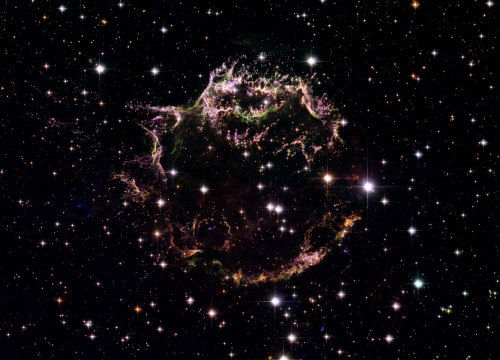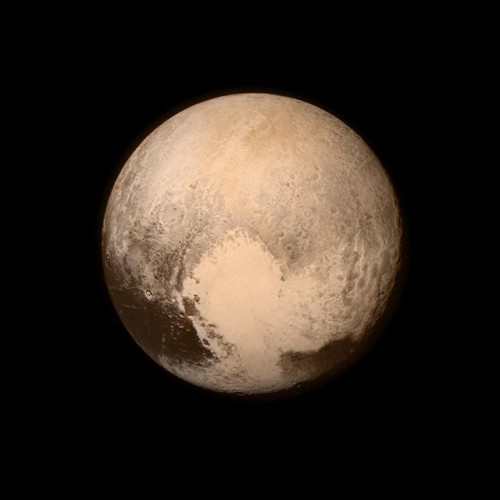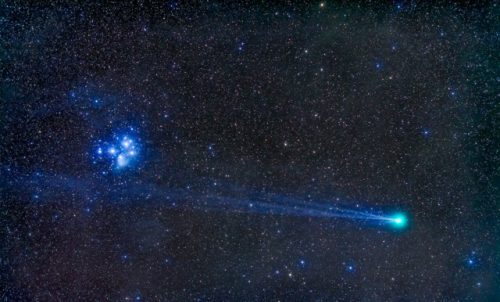Extraordinary Solar Halos Via NASA Https://go.nasa.gov/2LtZach

Extraordinary Solar Halos via NASA https://go.nasa.gov/2LtZach
More Posts from Xnzda and Others

Remains of supernova explosion Cassiopeia A most recent supernova in Milky Way
Charting the Milky Way From the Inside Out
NASA - Wide-field Infrared Survey Explorer (WISE) patch. June 4, 2015
Image above: This artist’s concept depicts the most up-to-date information about the shape of our own Milky Way galaxy. We live around a star, our sun, located about two-thirds of the way out from the center. Image credit: NASA/JPL-Caltech/R. Hurt (SSC/Caltech). Imagine trying to create a map of your house while confined to only the living room. You might peek through the doors into other rooms or look for light spilling in through the windows. But, in the end, the walls and lack of visibility would largely prevent you from seeing the big picture. The job of mapping our own Milky Way galaxy from planet Earth, situated about two-thirds of the way out from the galaxy’s center, is similarly difficult. Clouds of dust permeate the Milky Way, blocking our view of the galaxy’s stars. Today, researchers have a suitable map of our galaxy’s spiral structure, but, like early explorers charting new territory, they continue to patiently and meticulously fill in the blanks. Recently, researchers have turned to a new mapping method that takes advantage of data from NASA’s Wide-field Infrared Survey Explorer, or WISE. Using WISE, the research team has discovered more than 400 dust-shrouded nurseries of stars, which trace the shape of our galaxy’s spiral arms. Seven of these “embedded star clusters” are described in a new study published online May 20 in the Monthly Notices of the Royal Astronomical Society.
Image above: (Annotated) This artist’s concept depicts the most up-to-date information about the shape of our own Milky Way galaxy. We live around a star, our sun, located about two-thirds of the way out from the center. Image credit: NASA/JPL-Caltech/R. Hurt (SSC/Caltech). “The sun’s location within the dust-obscured galactic disk is a complicating factor to observe the galactic structure,” said Denilso Camargo, lead author of the paper from the Federal University of Rio Grande do Sul in Brazil. The results support the four-arm model of our galaxy’s spiral structure. For the last few years, various methods of charting the Milky Way have largely led to a picture of four spiral arms. The arms are where most stars in the galaxy are born. They are stuffed with gas and dust, the ingredients of stars. Two of the arms, called Perseus and Scutum-Centaurus, seem to be more prominent and jam-packed with stars, while the Sagittarius and Outer arms have as much gas as the other two arms but not as many stars. The new WISE study finds embedded star clusters in the Perseus, Sagittarius, and Outer arms. Data from the Two Micron All Sky Survey (2MASS), a ground-based predecessor of WISE from NASA, the National Science Foundation and the University of Massachusetts, Amherst, helped narrow down the distances to the clusters and pinpoint their location. Embedded star clusters are a powerful tool for visualizing the whereabouts of spiral arms because the clusters are young, and their stars haven’t yet drifted away and out of the arms. Stars begin their lives in the dense, gas-rich neighborhoods of spiral arms, but they migrate away over time. These embedded star clusters complement other techniques for mapping our galaxy, such as those used by radio telescopes, which detect the dense gas clouds in spiral arms.
Image above: Astronomers using data from NASA’s Wide-field Infrared Survey Explorer, or WISE, are helping to trace the shape of our Milky Way galaxy’s spiral arms. Image credit: NASA/JPL-Caltech/Federal University of Rio Grande do Sul. “Spiral arms are like traffic jams in that the gas and stars crowd together and move more slowly in the arms. As material passes through the dense spiral arms, it is compressed and this triggers more star formation,” said Camargo. WISE is ideal for finding the embedded star clusters because its infrared vision can cut through the dust that fills the galaxy and shrouds the clusters. What’s more, WISE scanned the whole sky, so it was able to perform a thorough survey of the shape of our Milky Way. NASA’s Spitzer Space Telescope also uses infrared images to map the Milky Way’s territory. Spitzer looks along specific lines of sight and counts stars. The spiral arms will have the densest star populations.
NASA’s Wide-field Infrared Survey Explorer, or WISE. Image Credit: NASA
NASA’s Jet Propulsion Laboratory in Pasadena, California managed and operated WISE for NASA’s Science Mission Directorate in Washington. The spacecraft was put into hibernation mode in 2011, after it scanned the entire sky twice, thereby completing its main objectives. In September 2013, WISE was reactivated, renamed NEOWISE and assigned a new mission to assist NASA’s efforts to identify potentially hazardous near-Earth objects. Other authors of the study are: Charles Bonatto and Eduardo Bica, also with the Federal University of Rio Grande do Sul. For more information on WISE, visit: http://www.nasa.gov/wise Previous research from Camargo’s team found two embedded clusters far outside the plane of our Milky Way, 16,000 light-years away. A feature story about that work is online at: http://www.jpl.nasa.gov/news/news.php?feature=4497 The new WISE study from the Monthly Notices of the Royal Astronomical Society is online at: http://mnras.oxfordjournals.org/content/450/4/4150.full?keytype=ref&ijkey=tjeJAezGAmgdXzc Images (mentioned), Text, Credits: NASA/Felicia Chou/JPL/Whitney Clavin/Tony Greicius. Best regards, Orbiter.ch Full article

The Infrared Visible Andromeda: This remarkable synthetic color composite image was assembled from archives of visible light and infrared astronomy image data. The field of view spans the Andromeda Galaxy are also included in the frame. via NASA
js
Holiday Lights from the Universe
Although there are no seasons in space, some cosmic vistas invoke thoughts of a frosty winter landscape. Here are a few stellar images of holiday wonderlands from across the galaxy…

Located in our galaxy about 5,500 light years from Earth, this region is actually a “cluster of clusters,” containing at least three clusters of young stars, including many hot, massive, luminous stars.

The outstretched “wings” of this nebula looks like a soaring, celestial snow angel. Twin lobes of super-hot gas, glowing blue in this image, stretch outward from the central star. This hot gas creates the “wings” of our angel. A ring of dust and gas orbiting the star acts like a belt, clinching the expanding nebula into an “hourglass” shape.

At this time of year, holiday parties often include festive lights. When galaxies get together, they also may be surrounded by a spectacular light show. This pair of spiral galaxies has been caught in a grazing encounter. This region has hosted three supernova explosions in the past 15 years and has produced one of the most bountiful collections of super-bright X-ray lights known.

What do the following things have in common: a cone, the fur of a fox and a Christmas tree? Answer: they all occur in the constellation of the unicorn (Monoceros). Pictured as a star forming region, the complex jumble of cosmic gas and dust is about 2,700 light-years away.

Resembling festive lights on a holiday wreath, this Hubble Space Telescope image of a nearby spiral galaxy is an iconic reminder of the impending season. Bright knots of glowing gas light up the spiral arms, indicating a rich environment of star formation.

The Hubble Space Telescope captured two festive-looking nebulas, situated so as to appear as one. Intense radiation from the brilliant central stars is heating hydrogen in each of the nebulas, causing them to glow red…like a holiday light.
Make sure to follow us on Tumblr for your regular dose of space: http://nasa.tumblr.com
-
 dgfmaurizio liked this · 4 years ago
dgfmaurizio liked this · 4 years ago -
 unwrappingthemystery liked this · 5 years ago
unwrappingthemystery liked this · 5 years ago -
 ermintrud liked this · 5 years ago
ermintrud liked this · 5 years ago -
 thatguyfromarizona-blog reblogged this · 5 years ago
thatguyfromarizona-blog reblogged this · 5 years ago -
 thatguyfromarizona-blog liked this · 5 years ago
thatguyfromarizona-blog liked this · 5 years ago -
 superbhoundtrashrascal liked this · 5 years ago
superbhoundtrashrascal liked this · 5 years ago -
 saraminia reblogged this · 5 years ago
saraminia reblogged this · 5 years ago -
 craving-for-mad-love liked this · 6 years ago
craving-for-mad-love liked this · 6 years ago -
 tavolr-456 liked this · 6 years ago
tavolr-456 liked this · 6 years ago -
 reaperalias287 liked this · 6 years ago
reaperalias287 liked this · 6 years ago -
 holyhydra liked this · 6 years ago
holyhydra liked this · 6 years ago -
 asimozouzouna reblogged this · 6 years ago
asimozouzouna reblogged this · 6 years ago -
 j1nseng reblogged this · 6 years ago
j1nseng reblogged this · 6 years ago -
 serendip8y reblogged this · 6 years ago
serendip8y reblogged this · 6 years ago -
 yellowemellow reblogged this · 6 years ago
yellowemellow reblogged this · 6 years ago -
 yellowemellow liked this · 6 years ago
yellowemellow liked this · 6 years ago -
 moongazinghare1111 liked this · 6 years ago
moongazinghare1111 liked this · 6 years ago -
 ynatsuchi liked this · 6 years ago
ynatsuchi liked this · 6 years ago -
 zadigo liked this · 6 years ago
zadigo liked this · 6 years ago -
 ro3000 reblogged this · 6 years ago
ro3000 reblogged this · 6 years ago -
 ro3000 liked this · 6 years ago
ro3000 liked this · 6 years ago -
 cybertaleartisan liked this · 6 years ago
cybertaleartisan liked this · 6 years ago -
 xnzda reblogged this · 6 years ago
xnzda reblogged this · 6 years ago -
 lingxieyue-blog liked this · 6 years ago
lingxieyue-blog liked this · 6 years ago -
 bydyydbyd liked this · 6 years ago
bydyydbyd liked this · 6 years ago -
 amalipeiris19900405 liked this · 6 years ago
amalipeiris19900405 liked this · 6 years ago -
 owl-sweaters liked this · 6 years ago
owl-sweaters liked this · 6 years ago -
 mihir-m3 liked this · 6 years ago
mihir-m3 liked this · 6 years ago -
 strangefanherringskeleton-blog liked this · 6 years ago
strangefanherringskeleton-blog liked this · 6 years ago -
 somnus-is-sleepy liked this · 6 years ago
somnus-is-sleepy liked this · 6 years ago -
 ombrellaa reblogged this · 6 years ago
ombrellaa reblogged this · 6 years ago -
 ombrellaa liked this · 6 years ago
ombrellaa liked this · 6 years ago -
 ancienthare liked this · 6 years ago
ancienthare liked this · 6 years ago -
 hanaalifia-blog liked this · 6 years ago
hanaalifia-blog liked this · 6 years ago -
 generalcollectionfiredragon-blog reblogged this · 6 years ago
generalcollectionfiredragon-blog reblogged this · 6 years ago


![M51, The Whirlpool Galaxy [3450 X 3697]](https://64.media.tumblr.com/e3d38132c6a1bab2d6a3d758e2137b6d/tumblr_plzsxlWKMO1ve10t6o1_500.jpg)









